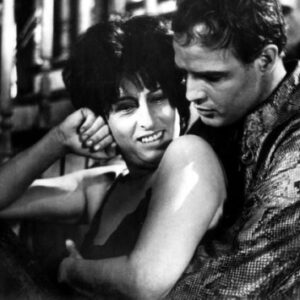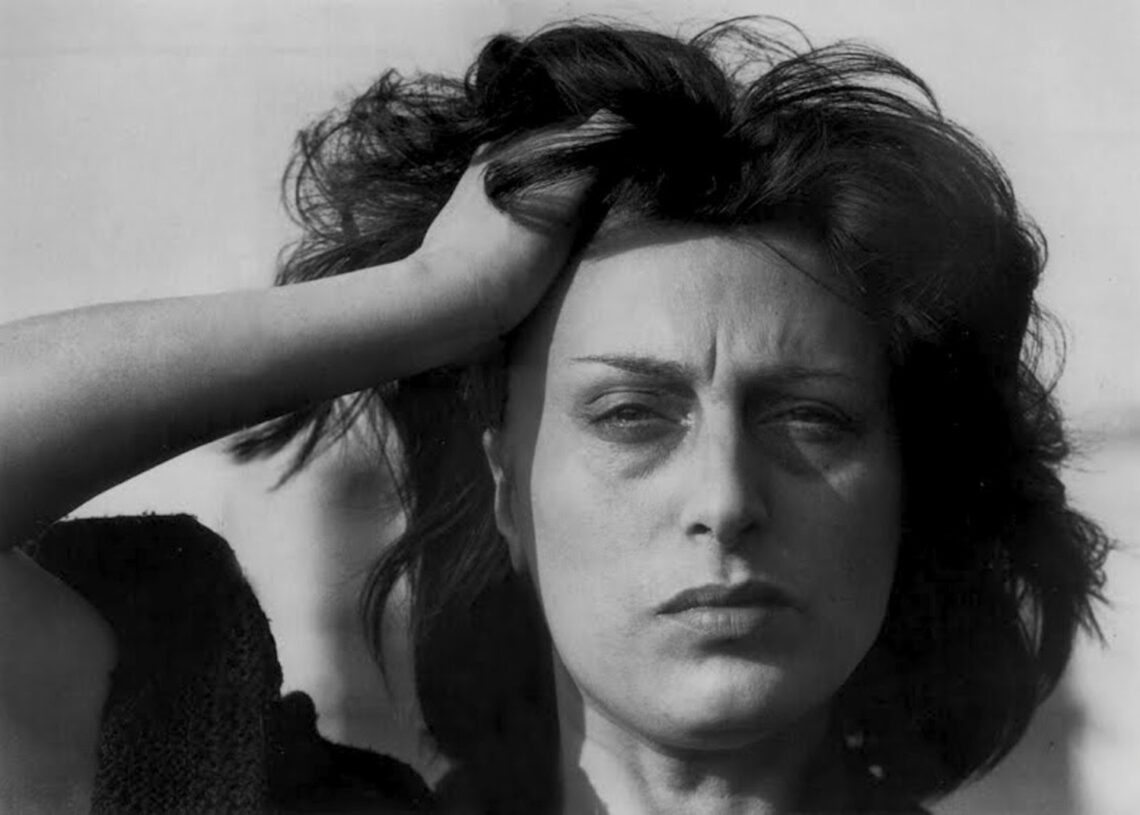LEGGI QUESTO ARTICOLO IN ITALIANO
Anna Magnani boarded the Andrea Doria in Naples in April 1953. It was her first trip to New York; she who did not like to fly, did not like to travel, and arrived in the city that everyone at that time had seen in the movies. Because of these movies, she already knew the city streets and skyscrapers yet here she found a city that she had not expected―she was so tied to Rome, she was profoundly Mediterranean; it was how Americans saw her and how she actually was.
The actress arrived in New York in May of that same year to present Luchino Visconti’s Bellissima at the Trans-Lux 60th Street theatre. That screening decreed the worldwide success of the film (after lukewarm attempts by Italians and the triumph of the French) and legitimized Anna Magnani as an international diva, an anomaly when compared to the Hollywood landscape: intense, difficult, fickle, authentic, not at all like the stars to whom people were accustomed.
Anna Magnani conquered America, and New York, and in its own way, it conquered her. “New York is a city that you don’t forget – she commented in a brief radio interview with Gianni Granzotto at that time – I find it real, human, truly human… without in any way prejudicing Paris or London, I find New York so very personal, it has a grand personality, like Rome […] There are no two cities like New York and Rome.” What struck her the most? “The violence, the spontaneous and honest aggression of its people…they are a genuine people.”
Other things that were said during that brief interview, as well as in books and chapters written over the years about Magnani and America―it was a brief yet fundamental relationship described as intermittent and not easy. But it was this immediate impression of New York’s authenticity, intense and violent truth that made an impression because it is real, and it is exactly this sensation that is reproduced and reconfirmed in every great film that talks about New York.
The welcome she received in New York at that time was extraordinary, “it surpasses my every expectation – Magnani commented with unusual discomfort at the microphone, almost embarrassed by her sudden role as an international star, unexpected even if persistently desired – I am moved by what I have seen, for what I have received, truly I am… I never thought that I would be remembered this way.” This was after she starred in only two films that had been distributed to the States: the most beloved Open City and The Miracle (the second episode of Rossellini’s film L’Amore, aka in America as Ways of Love, which sparked great controversy when released in New York in 1950 and which was subsequently censured and banned), and now Bellissima.


That was her first trip to New York, followed by another the next year, in October 1954, again on the Andrea Doria, this time Anna crossed the ocean with Tennessee Williams, who became a fast friend. He was a two-time Pulitzer Prize winner, one of the most prominent playwrights of that period, and author of The Rose Tattoo. The actress would later star in that movie with Burt Lancaster, directed by Daniel Mann, a play that Williams wrote specifically for her. On March 21, 1956, Magnani won the Best Actress Oscar for her role, a first for an Italian actress, and even more significant, a performance in English by an Italian actress.
On the opening night of The Rose Tattoo at the Astor Theater (historic theater in New York that opened many movies, including Gone with the Wind), on December 12, 1955, even before Magnani’s Oscar nomination was announced, Time Magazine dedicated three columns to her, defining her as the “best actress in the world.” And so it was. Magnani was not present at the awards ceremony in Los Angeles nor was she present at the triumphant opening night in New York for the film, but in the early morning of December 13, she was awaken by a phone call from Hall Wallis, her producer and friend, who shared with her the extraordinary success of opening night of her film in New York (the proceeds of which, btw, were donated to the Actors’ Studio). The emotion Anna Magnani felt was overwhelming, as she wrote in a telegram a few days later, she who was so proud, direct, testy, fiery, and so far away from America and Hollywood.
There were an additional two American films for Magnani: Wild is the Wind (Selvaggio è il vento) directed by George Cukor, co-starring Anthony Quinn and Anthony Franciosa, and The Fugitive Kind (Pelle di serpente) directed by Sidney Lumet Sidney Lumet, co-starring Marlon Brando and Joanne Woodward. There would be other American projects to follow, however they never materialized.
The third time Anna Magnani visited New York was for a press conference, before going to Hollywood and Nevada to shoot Wild is the Wind. It was February 27, 1957, the Cristoforo Columbus was docked at Pier 84 on the West Side (the glorious Andrea Doria had sunk in Nantucket the year before). She received another nomination in 1958, and then won Best Actress at the Berlin Film Festival, Festival di Berlino, and what’s more her first David di Donatello award. David di Donatello for Wild is the Wind. And then there would be her love story with Anthony Franciosa.

Magnani’s fourth visit to New York was instead to shoot (at studios in the Bronx) her third American film, The Fugitive Kind, a film that arrived from afar, this too written by her friend Tennessee Williams, who had already written a version of Orpheus Descending in 1940, with the title Battle of Angels (which was a colossal flop on Broadway). He then revised it in 1957 and wanted Magnani to star in it but for a year she refused to do Broadway―her son was ill and she wanted to be with him, and then she had other movie commitments in Italy; she was not convinced. On Broadway, Elia Kazan was to have directed and Marlon Brando was to have been her co-star, since she had wanted to perform with him for some time. But Brando himself was not convinced and also too busy. A possible alternate, Franciosa (who Magnani did not know at the time), or another actor, and for this reason she wrote to her friend Hal: “I wanted to ask your advice about another actor whose name is Paul Newman. What’s he like in your opinion? Could you tell me something about him?” Kazan, at a later point withdrew from the project, just when it seemed that Magnani was more open to the idea. Williams’ comedy went on just the same, without them, but was anything but successful. The only thing left was to make a movie starring Magnani. In 1959 the opportunity arose, with Sidney Lumet and Marlon Brando too. The deep south of the movie was actually Milton (upstate New York), where during movie takes, Magnani was often seen in the post office sending letters and telegrams to Rome… Brando and Magnani were far too similar, both great actors, strong willed, fiery, absolute in their own right, and the two argued often, both during and after takes. Biographers and various commentators wrote things, unpleasant things also, whether or not true, it didn’t matter. Anna Magnani was never happy about the film, which was too excessive, too Hollywood. She remembered that Lumet “di not take care of us actors,” he was unlike Daniel Mann, who one day had sat with her and asked her to become the best version of herself possible for the role of Serafina in The Rose Tattoo.
While she was in New York (or at least in the vicinity) for the filming of The Fugitive Kid, it was she who presented the David di Donatello award to Marilyn Monroe (see video below) for her performance a year earlier in The Prince and the Showgirl. The brief recorded testimony of that moment shows a Marilyn who was sincerely moved by the award, a Magnani who was at home at the Italian Cultural Institute in New York, and at the microphone “this is Ruggero Orlando,” with that unforgettable voice.
There are other things that could be said about Anna Magnani in New York: about her American correspondence (which can be read, by the way, in a interesting book by Cristina and Luigi Vaccarella), and about her American movies, those made and those tried. But truth be told, the only thing that should be done is to watch and rewatch her movies: there you will find the complete Magnani.
This incredible opportunity is presented by the Lincoln Center in collaboration with the Istituto Luce Cinecittà: from May 18th to June 1st will be screened 24 of Anna Magnani’s movies, both on 35mm and 16mm . This great retrospective will be travelling to numerous American and Canadian cities after New York, and provides a diverse survey of Magnani’s filmography, ranging from Tempo Massimo (Full Speed) directed by Mario Mattioli (1934, her third movie) to Roma directed by Federico Fellini: with that door closed, we bid a symbolic farewell to Anna Magnani of the movies, as it was her last, and then shortly thereafter, to Magnani herself. The other films being shown are Roma città aperta (Rome Open City), L’onorevole Angelina (Angelina), Bellissima, The Rose Tattoo (La rosa tatuata), Mamma Roma, Teresa venerdì (Doctor, Beware), Vulcano (Volcano), Risate di gioia (The Passionate Thief), La carrosse d’or (The Golden Coach), Wild is the Wind (Selvaggio è il vento), The Fugitive Kind (Pelle di serpente), Nella città l’inferno, e many more.
There were also the great directors: Rossellini, Visconti, Camerini, De Sica, Pasolini, Monicelli, Renoir, Cukor, Lumet, Fellini: the entire history of cinematography in the movies of Anna Magnani.
Watch the video of the RAI TV recorded presentation to Marilyn Monroe of the David di Donatello Award by Anna Magnani (in Italian):
Translated from Italian by Enza Antenos.












